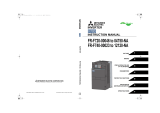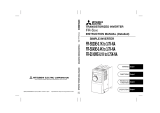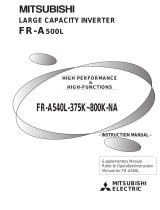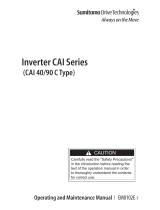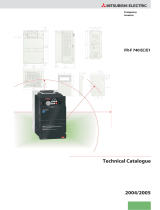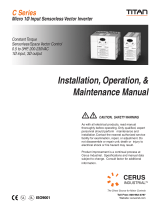Page is loading ...

TRANSISTORIZED INVERTER
FR
-
C
500
INSTRUCTION MANUAL
INSTALLATION AND
WIRING
Chapter 1
OPERATION AND
CONTROL
Chapter 2
INVERTER
FUNCTIONS
Chapter 3
PLC FUNCTION
Chapter 4
CC-Link
COMMUNICATION
Chapter 5
PROTECTIVE
FUNCTIONS
Chapter 6
SPECIFICATIONS
Chapter 7
FR-C
500
INSTRUCTION MANUAL
TRANSISTORIZED INVERTER
HEAD OFFICE:MITSUBISHI DENKI BLDG MARUNOUCHI TOKYO 100-8310
INVERTER WITH BUILT-IN PLC FUNCTION
(plus COMMUNICATION COMPATIBILITY)
FR-C520-0.1K
to
3.7K
IB(NA)-0600114E-A(0208)MEE
Printed in Japan Specifications subject to change without notice.

A-1
This instruction manual gives handling information and precautions for use of this
product.
Please forward this manual to the end user.
1. Electric Shock Prevention
2. Fire Prevention
This section is specifically about safety matters
Do not attempt to install, operate, maintain or inspect the inverter until you have read
through this instruction manual and appended documents carefully and can use the
equipment correctly. Do not use the inverter until you have a full knowledge of the
equipment, safety information and instructions.
In this instruction manual, the safety instruction levels are classified into "WARNING"
and "CAUTION".
Assumes that incorrect handling may cause hazardous
conditions, resulting in death or severe injury.
Assumes that incorrect handling may cause hazardous
conditions, resulting in medium or slight injury, or may cause
physical damage only.
Note that even the level may lead to a serious consequence
according to conditions. Please follow the instructions of both levels as they are
important to personnel safety.
WARNING
!
!!
!
While power is on or when the inverter is running, do not open the front cover. You
may get an electric shock.
!
!!
!
Do not run the inverter with the front cover removed. Otherwise, you may access
the exposed high-voltage terminals or the charging part of the circuitry and get an
electric shock.
!
!!
!
If power is off, do not remove the front cover except for wiring or periodic inspection.
You may access the charged inverter circuits and get an electric shock.
!
!!
!
Before starting wiring or inspection, switch power off, wait for more than at least 10
minutes and check for the presence of any residual voltage with a meter, etc.
!
!!
!
Earth (ground) the inverter in a class D or higher protective earthing (grounding)
method.
!
!!
!
Any person who is involved in the wiring or inspection of this equipment should be
fully competent to do the work.
!
!!
!
Always install the inverter before wiring. Otherwise, you may get an electric shock
or be injured.
!
!!
!
Operate the switches with dry hands to prevent an electric shock.
!
!!
!
Do not subject the cables to scratches, excessive stress, heavy loads or pinching.
Otherwise, you may get an electric shock.
!
!!
!
Do not change the cooling fan with power on. It is dangerous to change the cooling
fan while power is on.
CAUTION
!
!!
!
Mount the inverter on incombustible material. Mounting it to or near combustible
material can cause a fire.
!
!!
!
If the inverter has become faulty, switch off the inverter power. A continuous flow of
large current could cause a fire.
!
!!
!
Do not connect a resistor directly to the DC terminals P(+), N(+). This could cause a fire.
WARNING
CAUTION
CAUTION

A-2
3. Injury Prevention
4. Additional instructions
Also note the following points to prevent an accidental failure, injury, electric shock, etc.:
(1) Transportation and installation
(2) Wiring
(3) Trial run
CAUTION
!
!!
! Apply only the voltage specified in the instruction manual to each terminal to pre-
vent damage, etc.
!
!!
! Ensure that the cables are connected to the correct terminals. Otherwise, damage,
etc. may occur.
!
!!
! Always make sure that polarity is correct to prevent damage, etc.
!
!!
! While power is on or for some time after power-off, do not touch the inverter or
brake resistor as they are hot and you may get burnt.
CAUTION
!
!!
! When carrying products, use correct lifting gear to prevent injury.
!
!!
! Do not stack the inverter boxes higher than the number recommended.
!
!!
! Ensure that installation position and material can withstand the weight of the
inverter. Install according to the information in the Instruction Manual.
!
!!
! Do not operate if the inverter is damaged or has parts missing.
!
!!
! Do not hold the inverter by the front cover; it may fall off.
!
!!
! Do not stand or rest heavy objects on the inverter.
!
!!
! Check the inverter mounting orientation is correct.
!
!!
! Prevent screws, wire fragments or other conductive bodies, oil or other flammable
substances from entering the inverter.
!
!!
! Do not drop the inverter, or subject it to impact.
!
!!
! Use the inverter under the following environmental conditions:
*Temperatures applicable for a short time, e.g. in transit.
CAUTION
!
!!
! Do not fit capacitive equipment such as power factor correction capacitor, radio
noise filter or surge suppressor to the output of the inverter.
!
!!
! The connection orientation of the output cables U, V, W to the motor will affect the
direction of rotation of the motor.
CAUTION
!
!!
! Check all parameters, and ensure that the machine will not be damaged by a sud-
den start-up.
Environment
Ambient
temperature
-10°C to +50°C (non-freezing)
Ambient
humidity
90%RH or less (non-condensing)
Storage
temperature
-20°C to +65°C*
Ambience
Indoors (free from corrosive gas, flammable gas, oil mist,
dust and dirt)
Altitude,
vibration
Max. 1000m above sea level
5.9m/s
2
{0.6G} or less (conforming to JIS C 0040)

A-3
(4) Operation
(5) Emergency stop
(6) Maintenance, inspection and parts replacement
(7) Disposing of the inverter
(8) General instructions
WARNING
!
!!
! The [STOP] key is valid only when the appropriate function setting has been made.
Prepare an emergency stop switch separately.
!
!!
! Make sure that the start signal is off before resetting the inverter alarm. A failure to
do so may restart the motor suddenly.
!
!!
! The load used should be a three-phase induction motor only. Connection of any
other electrical equipment to the inverter output may damage the equipment.
!
!!
! Do not modify the equipment.
CAUTION
!
!!
! The electronic overcurrent protection does not guarantee protection of the motor
from overheating.
!
!!
! Do not use a magnetic contactor on the inverter input for frequent starting/stopping
of the inverter.
!
!!
! Use a noise filter to reduce the effect of electromagnetic interference. Otherwise
nearby electronic equipment may be affected.
!
!!
! Take measures to suppress harmonics. Otherwise power harmonics from the
inverter may heat/damage the power capacitor and generator.
!
!!
! When parameter clear is performed, each parameter returns to the factory setting.
Re-set the required parameters before starting operation.
!
!!
! The inverter can be easily set for high-speed operation. Before changing its set-
ting, fully examine the performances of the motor and machine.
!
!!
! In addition to the inverter's holding function, install a holding device to ensure
safety.
!
!!
! Before running the inverter which had been stored for a long period, always per-
form inspection and test operation.
CAUTION
!
!!
! Provide a safety backup such as an emergency brake which will prevent the
machine and equipment from hazardous conditions if the inverter fails.
CAUTION
!
!!
! Do not carry out a megger (insulation resistance) test on the control circuit of the
inverter.
CAUTION
!
!!
! Treat as industrial waste.
Many of the diagrams and drawings in this instruction manual show the inverter
without a cover, or partially open. Never operate the inverter in this status. Always
replace the cover and follow this instruction manual when operating the inverter.

I
CONTENTS
1. INSTALLATION AND WIRING 1
1.1 Basic Configuration.....................................................................2
1.2 Precautions for Use ....................................................................3
1.3 Installation of the Inverter............................................................3
1.4 Terminal Connection Diagram....................................................5
1.5 Wiring of the Power Supply and Motor........................................6
1.5.1 Description of the main circuit terminals....................................................... 6
1.5.2 Layout and wiring of the main circuit terminals............................................. 6
1.5.3 Cables, wiring lengths, crimping terminals, etc............................................. 6
1.6 Earthing (Grounding) Precautions...............................................7
1.7 Control Circuit .............................................................................8
1.7.1 Description of the control circuit terminals.................................................... 8
1.7.2 Layout and wiring of the control circuit terminals........................................ 10
1.7.3 Layout and wiring of the CC-Link terminals................................................ 11
1.7.4 Changing the control logic .......................................................................... 12
1.7.5 RS-485 Connector...................................................................................... 14
1.7.6 Connection of the parameter unit (FR-PU04)............................................. 14
1.8 Input Terminals .........................................................................15
1.8.1 Run (start) and stop (STF, STR)................................................................. 15
1.8.2 External frequency selection (RH, RM, RL)................................................ 17
1.8.3 Control circuit common terminals (SD, SE) ................................................ 18
1.8.4 Signal inputs by contactless switches......................................................... 18
1.9 How to Use the Input Signals (Assigned Terminals RL, RM, RH,
STR, SQ) ..................................................................................19
1.9.1 Multi-speed setting (RL, RM, RH signals): Pr. 60 to Pr. 63, Pr. 65, Pr. 505
setting "0, 1, 2"............................................................................................ 19
1.9.2 Output shut-off (MRS signal): Pr. 60 to Pr. 63, Pr. 65, Pr. 505 setting "6".. 19
1.9.3 External thermal relay input: Pr. 60 to Pr. 63, Pr. 65, Pr. 505 setting "7".... 19
1.9.4 Reset signal: Pr. 60 to Pr. 63, Pr. 65, Pr. 505 setting "10".......................... 20
1.9.5 Start (forward rotation) signal: Pr. 65 setting "17"....................................... 20
1.9.6 Sequence start: Pr. 60 to Pr. 63, Pr. 65, Pr. 505 setting "50" ..................... 21
1.9.7 No function: Pr. 60 to Pr. 63, Pr. 65, Pr. 505 setting "9998"....................... 21
1.9.8 Start (reverse rotation) signal: Pr. 63 setting "9999"................................... 21
1.10 Peripheral Devices....................................................................22
1.10.1 Peripheral device list................................................................................... 22
1.10.2 Leakage current and installation of earth (ground) leakage circuit breaker 22
1.10.3 Power-off and magnetic contactor (MC)..................................................... 26
1.10.4 Regarding the installation of the power factor improving reactor................ 27
1.10.5 Regarding noises and the installation of the noise filter.............................. 28
1.10.6 Power harmonics........................................................................................ 29

II
CONTENTS
1.10.7 Power harmonic suppression guideline.......................................................30
1.11 Connection of Stand-Alone Option Units...................................33
1.11.1 Connection of the conventional BU brake unit (option)...............................33
1.11.2 Connection of the FR-HC high power factor converter (option)..................33
1.11.3 Connection of the power regeneration common converter (FR-CV)...........34
1.12 Wiring of the Inverter and Personal Computer Using
GX Developer for RS-485 Communication ...............................35
1.13 Wiring for CC-Link Communication...........................................36
1.14 Wiring of the Inverter and Computer Using
RS-485 communication.............................................................38
1.15 Design Information ....................................................................40
2. OPERATION AND CONTROL 41
2.1 Parts Identification and Functions of the
Operation Panel ........................................................................42
2.2 Operation Mode Switching ........................................................42
2.3 Monitor Transition......................................................................43
2.4 Monitoring the Output Current...................................................43
2.5 Displaying the CC-Link Data (Station Number, Baudrate) ........43
2.6 LED On/Off Operations .............................................................44
2.6.1 How to check the LED lamps for CC-Link
communication errors..................................................................................45
3. INVERTER FUNCTIONS 49
3.1 Function (Parameter) List..........................................................50
3.2 List of Parameters Classified by Purpose of Use......................55
3.3 Basic Functions.........................................................................56
3.3.1 Torque boost (Pr. 0)....................................................................................56
3.3.2 Maximum and minimum frequencies (Pr. 1, Pr. 2)......................................57
3.3.3 Base frequency (Pr. 3) ................................................................................58
3.3.4 Multi-speed operation (Pr. 4, Pr. 5, Pr. 6)....................................................59
3.3.5 Acceleration/deceleration time (Pr. 7, Pr. 8)................................................60
3.3.6 Electronic thermal O/L relay (Pr. 9).............................................................61
3.3.7 DC injection brake (Pr. 10, Pr. 11, Pr. 12)...................................................61
3.3.8 Starting frequency (Pr. 13)..........................................................................62
3.3.9 key rotation direction selection (Pr. 17)...........................................63
3.3.10 Stall prevention function and current limit function
(Pr. 21, Pr. 22).............................................................................................63
3.3.11 Start-time earth (ground) fault detection selection (Pr. 40) .........................66
3.4 Operation Panel Display Selection............................................67
RUN

III
3.4.1 Monitor display (Pr. 52)............................................................................... 67
3.5 I/O Terminal Function Selection................................................68
3.5.1 Input terminal function selection (Pr. 60, Pr. 61, Pr. 62,
Pr. 63, Pr. 65, Pr. 505)............................................................................... 68
3.5.2 Output terminal function selection (Pr. 64, Pr. 505).................................... 69
3.6 Operation Selection Function Parameters................................70
3.6.1 Applied motor (Pr. 71)................................................................................. 70
3.6.2 PWM carrier frequency (Pr. 72).................................................................. 70
3.6.3 Reset selection/PU stop selection (Pr. 75) ................................................. 71
3.6.4 Cooling fan operation selection (Pr. 76)...................................................... 73
3.6.5 Parameter write disable selection (Pr. 77).................................................. 74
3.6.6 Operation mode and command source (Pr. 79, Pr. 338,
Pr. 339, Pr. 340).......................................................................................... 75
3.7 Computer Link Operation Setting..............................................79
3.7.1 Communication settings (Pr. 331 to Pr. 337, Pr. 341) ................................ 79
3.7.2 E2PROM write selection (Pr. 342).............................................................. 92
3.8 Parameter Unit (FR-PU04) Setting ...........................................93
3.8.1 Parameter display language selection (Pr. 145)......................................... 93
3.8.2 PU buzzer control (Pr. 990) ........................................................................ 93
3.8.3 PU contrast adjustment (Pr. 991)................................................................ 94
3.8.4 PU main display screen data selection (Pr. 992)........................................ 94
3.8.5 PU disconnection detection/PU setting lock (Pr. 993) ................................ 95
4. PLC FUNCTION 97
4.1 System Configuration................................................................98
4.2 Prior to Sequence Program Creation........................................99
4.2.1 Precautions for sequence program creation............................................... 99
4.2.2 Usable main GX Developer functions......................................................... 99
4.2.3 Sequence program execution key ............................................................ 100
4.2.4 Sequence program write........................................................................... 101
4.3 Function Block Diagram..........................................................102
4.3.1 Setting list of built-in PLC function parameter........................................... 103
4.4 PLC Instructions......................................................................104
4.4.1 How to use the instruction list................................................................... 104
4.4.2 PLC instruction list.................................................................................... 106
4.5 Device Map.............................................................................109
4.5.1 I/O device map.......................................................................................... 109
4.5.2 Internal relay (M) device map ................................................................... 110
4.5.3 Data register (D) device map.................................................................... 110
4.5.4 Special relays............................................................................................ 112
4.5.5 Special registers ....................................................................................... 112
4.6 Inputs/Outputs.........................................................................114

IV
CONTENTS
4.6.1 Input (X) assignment.................................................................................114
4.6.2 Output (Y) assignment ..............................................................................116
4.7 Inverter Status Monitoring, Special Registers for Control .......117
4.7.1 Data that can be read at all times..............................................................117
4.7.2 Data that are read by controlling (OFF to ON) the read command...........119
4.7.3 How to write data by controlling (OFF to ON) the write
command..................................................................................................121
4.7.4 Inverter operation status control................................................................126
4.7.5 Inverter parameter access error (D9150)..................................................128
4.7.6 Inverter status (D9151)..............................................................................128
4.8 Inverter Parameter Read/Write Method ..................................129
4.8.1 Reading the inverter parameters...............................................................130
4.8.2 Writing the inverter parameters.................................................................132
4.9 User Area Read/Write Method ................................................135
4.9.1 User parameter read/write method............................................................135
4.10 Debugging Mode Specifications..............................................136
4.11 Register Display ......................................................................137
4.12 Inverter Operation Lock Mode Setting.....................................138
5. CC-Link COMMUNICATION 139
5.1 System Configuration..............................................................140
5.1.1 System configuration example..................................................................140
5.1.2 Regarding CC-Link Ver. 1.10....................................................................140
5.1.3 Function block diagram.............................................................................141
5.2 CC-Link Parameters................................................................143
5.2.1 Setting of station number and baudrate (Pr. 503, Pr. 504)........................143
5.2.2 Regarding the operation mode..................................................................143
5.2.3 Operation at CC-Link communication error occurrence............................144
5.3 CC-Link I/O Specifications ......................................................145
5.4 Buffer Memory.........................................................................148
5.4.1 Remote output signals (Master module to inverter) ..................................148
5.4.2 Remote input signals (Inverter to master module) ....................................149
5.4.3 Remote registers (Master module to inverter)...........................................150
5.4.4 Remote registers (Inverter to master module)...........................................151
6. PROTECTIVE FUNCTIONS 153
6.1 Errors (Alarms)........................................................................154
6.1.1 Error (alarm) definitions.............................................................................155
6.1.2 To know the operating status at the occurrence of alarm
(Only when FR-PU04 is used)..................................................................161
6.1.3 Correspondences between digital and actual characters..........................161

V
6.1.4 Resetting the inverter................................................................................ 161
6.2 Troubleshooting ......................................................................162
6.2.1 Motor remains stopped............................................................................. 162
6.2.2 Motor rotates in opposite direction............................................................ 162
6.2.3 Speed greatly differs from the setting ....................................................... 163
6.2.4 Acceleration/deceleration is not smooth................................................... 163
6.2.5 Motor current is large................................................................................ 163
6.2.6 Speed does not increase.......................................................................... 163
6.2.7 Speed varies during operation.................................................................. 163
6.2.8 Operation mode is not changed properly.................................................. 164
6.2.9 Operation mode is not switched to CC-Link operation mode.................... 164
6.2.10 Inverter cannot be started in CC-Link operation mode............................. 164
6.2.11 Operation panel display is not provided.................................................... 164
6.2.12 Parameter write cannot be performed ...................................................... 164
6.2.13 Motor produces annoying sound............................................................... 164
6.3 Precautions for Maintenance and Inspection..........................165
6.3.1 Precautions for maintenance and inspection............................................ 165
6.3.2 Check items.............................................................................................. 165
6.3.3 Periodic inspection.................................................................................... 165
6.3.4 Insulation resistance test using megger.................................................... 166
6.3.5 Pressure test............................................................................................. 166
6.3.6 Daily and periodic inspection.................................................................... 167
6.3.7 Replacement of parts................................................................................ 171
6.3.8 Measurement of main circuit voltages, currents and powers.................... 174
7. SPECIFICATIONS 177
7.1 Ratings....................................................................................178
7.2 Common Specifications ..........................................................179
7.3 PLC Function Specifications...................................................180
7.4 CC-Link Interface Specifications.............................................180
7.5 Outline Drawings.....................................................................181
APPENDICES 183
Appendix 1 Parameter Data Codes for Computer Link
Operation Using RS-485 Communication....................184
Appendix 2 Instructions for Compliance with
the European Standards..............................................187
Appendix 3 Instructions for compliance with U.S. and Canadian
Electrical Codes...........................................................189

1
Chapter 7
Chapter 6
Chapter 5
Chapter 4
Chapter 3
Chapter 2
Chapter 1
1. INSTALLATION
AND WIRING
This chapter explains the "installation and wiring" for use of this
product.
Always read the instructions before use.
1.1 Basic Configuration ............................................. 2
1.2 Precautions for Use ............................................. 3
1.3 Installation of the Inverter ................................... 3
1.4 Terminal Connection Diagram............................. 5
1.5 Wiring of the Power Supply and Motor .............. 6
1.6 Earthing (Grounding) Precautions ..................... 7
1.7 Control Circuit ...................................................... 8
1.8 Input Terminals..................................................... 15
1.9 How to Use the Input Signals (Assigned
Terminals RL, RM, RH, STR, SQ)
............................
19
1.10 Peripheral Devices............................................... 22
1.11 Connection of Stand-Alone Option Units .......... 33
1.12 Wiring of the Inverter and Personal Computer
Using GX Developer for RS-485 Communication
35
1.13 Wiring for CC-Link Communication.................... 36
1.14 Wiring of the Inverter and Computer Using RS-
485 communication
......................................................
38
1.15 Design Information............................................... 40
<Trademarks>
• CC-Link is a registered trademark of CC-Link Partner
Association.
• Other company and product names herein are the trademarks
or registered trademarks of their respective owners.

2
Basic Configuration
1.1 Basic Configuration
Power supply
Use within the permissible power supply specifications of the
inverter. (Refer to page 178.)
No-fuse breaker or earth leakage circuit breaker
The breaker must be selected carefully since an inrush current
flows in the inverter at power-on. (Refer to page 22.)
Magnetic contactor
Do not use this magnetic contactor to start and stop the inverter.
Doing so will cause the inverter life to be shorter. (Refer to page
22.)
Installation of reactors
The reactors must be used when the power factor is to be
improved or the inverter is installed near a large power supply
system (500kVA or more and wiring distance within 10m). Make
selection carefully. (Refer to page 22.)
Devices connected to the output
Do not connect a power factor correction capacitor, surge
suppressor or radio noise filter to the output side.
Earth (Ground)
To prevent an electric shock, always earth (ground) the motor and
inverter.
For reduction of induction noise from the power line of the
inverter, it is recommended to wire the earth (ground) cable by
returning it to the earth (ground) terminal of the inverter.
(For details of noise reduction techniques, refer to page 28.)
REMARKS
•When using the PLC function, refer to page 35 for wiring and to page 98 for details.
•When using the CC-Link function, refer to page 36 for wiring and to page 140 for details.
(MC)
(NFB)
or
(ELB)
AC reactor
(FR-BAL)
Earth
(Ground)
Earth (Ground)
DC reactor
(FR-BEL)
Inverter
The inverter life is influenced by ambient temperature. The
ambient temperature should be as low as possible within the
permissible range. (Refer to page 4.)
Wrong wiring might lead to damage of the inverter. The control
signal wires must be kept fully away from the main circuit to
protect them from noise. (Refer to page 5.)

3
Precautions for Use
1
INSTALLATION AND WIRING
1.2 Precautions for Use
The "harmonic suppression guideline for household appliances and general-purpose
products" issued by the Ministry of Economy, Trade and Industry (formerly Ministry of
International Trade and Industry) in September, 1994 applies to the FR-C500 series.
By installing the FR-BEL or FR-BAL power factor improving reactor, this product
complies with the "harmonic suppression techniques for transistorized inverters (input
current 20A or less)" established by the Japan Electrical Manufacturers' Association.
Unpack the inverter and check the capacity plate on the front cover and the rating
plate on the inverter side face to ensure that the product agrees with your order and
the inverter is intact.
1.3 Installation of the Inverter
Harmonic Suppression Guideline
Product Checking and Parts Identification
Operation panel
Part names and plates
CC-LINK connector
PU connector
(RS-485 connector)
Front cover
Control circuit terminal block
Main circuit terminal block
Wiring cover
Rating plate
Inverter type
Input rating
Output rating
Serial number
Capacity plate
Inverter type
Serial number
Enclosure surface mounting
Leave enough clearances and
provide cooling measures.
Fix the front
cover and wiring
cover after
removing them.
Mounting inside enclosure
When containing two or more
inverters, install them in parallel
and provide cooling measures.

4
Installation of the Inverter
! Install the inverter under the following conditions:
! The inverter consists of precision mechanical and electronic parts. Never install or
handle it in any of the following conditions as doing so could cause an operation
fault or failure.
! Removal and reinstallation of the front
cover
Remove the front cover by pulling it
toward you in the direction of arrow.
To reinstall, match the cover to the inverter
front and install it straight.
! Removal and reinstallation of the wiring cover
The cover can be removed easily by pulling it toward
you.
To reinstall, fit the cover to the inverter along the guides.
! Wiring of the RS-485 communication connector
When using the RS-485 connector to wire the cable, you
can cut off the lug of the wiring cover to wire it.
Vertical mounting
Vertical
Ambient temperature and humidity
Clearances
1cm or
more
10cm or
more
1cm or
more
10cm or
more
Temperature: -10 to 50
Humidity: 90%RH maximum
C C
Clearances also necessary for
changing the cooling fan.
(1.5K or more)
Direct sunlight
Vibration
(5.9m/s
2
max.)
High temperature,
high humidity
Horizontal placement
Vertical mounting (When
mounted inside enclosure)
Transportation by
holding front cover
Oil mist,
flammable gas,
corrosive gas,
fluff, dust, etc.
Mounting to
combustible material
FR-C520-0.1K to 0.75K FR-C520-1.5K to 3.7K
Wiring
cover
Lug

5
Terminal Connection Diagram
1
INSTALLATION AND WIRING
1.4 Terminal Connection Diagram
! Three-phase 200V power input
REMARKS
*1. You can change the control logic between sink and source logic. Refer to page 12 for details.
*2. The terminal functions change with input terminal function selection (Pr. 60 to Pr. 63, Pr.
65, Pr. 505). (Refer to page 68)
(RES, RL, RM, RH, MRS, OH, STR, STF, SQ signal, without function selection)
*3. The terminal functions change with output terminal function selection (Pr. 64, Pr. 506).
(Refer to page 69.) (RUN, OL, ALM signal, without function selection)
*4. Only either the personal computer (e.g. GX Developer) or parameter unit can be
connected to the PU connector.
*5. For details of the I/O device, refer to page 109.
CAUTION
To prevent a malfunction due to noise, keep the signal cables more than 10cm away
from the power cables.
Be careful not to short
PC-SD.
NFB
R
S
T
PC
STF
STR
RM
RUN
SE
IM
U
V
W
P1
P
N
MC
SINK
SOURCE
: Main circuit terminal
: Control circuit terminal
SD
*1
RL
RH
DA
DB
DG
SLD
DA
DB
DG
SLD
SLD
FG
Parameter unit
(FR-PU04)
*4
ALM
SQ
Three-phase AC
power supply
External transistor common
24VDC power supply
Contact input common (source)
Forward rotation start
Reverse rotation start
Multi-speed
selection
High
Middle
Low
Sequence start
Contact input common
Control input signals
(No voltage input allowed)
Personal
computer
RS-232C
-RS-485
converter
CC-Link communication signals
PLC CC-Link
master module
Inverter
PU connector
(RS-485)
Motor
Earth
(Ground)
Power factor improving
DC reactor
(FR-BEL: Option)
Jumper: Remove
this jumper when
FR-BEL is connected.
Running
Alarm
output
Output
terminals *3
Open
collector
output
Open
collector
output common
Earth (Ground)
*2
Input terminals
*5
(X0)
(X1)
(X4)
(X3)
(X2)
(X5)
(Y0)
(Y1)
*5

6
Wiring of the Power Supply and Motor
1.5 Wiring of the Power Supply and Motor
1.5.1 Description of the main circuit terminals
1.5.2 Layout and wiring of the main circuit terminals
1.5.3 Cables, wiring lengths, crimping terminals, etc.
The following selection example assumes the wiring length of 20m.
1) FR-C520-0.1K to 3.7K
Symbol Terminal Name Description
R/L1, S/L2, T/L3 Power input
Connect to the commercial power supply.
U, V, W Inverter output
Connect a three-phase squirrel-cage motor.
N/- DC voltage common
DC voltage common terminal. Not isolated from the
power supply and inverter output.
P/+, P1
Power factor
improving DC
reactor connection
Disconnect the jumper from terminals P-P1 and
connect the optional power factor improving DC
reactor (FR-BEL).
Earth (Ground)
For earthing (grounding) the inverter chassis. Must
be earthed (grounded).
!
FR-C520-0.1K, 0.2K, 0.4K, 0.75K
!
FR-C520-1.5K, 2.2K, 3.7K
CAUTION
•Always connect the power supply cables to R/L1, S/L2 and T/L3. Never
connect them to U, V and W since it will damage the inverter. (The phase
sequence need not be matched.)
•Connect the motor to U, V and W. When the forward rotation switch (signal) is
turned on at this time, the motor rotates in the counterclockwise direction as
viewed from the load shaft.
Applicable
Inverter Type
Terminal
Screw
Size
Tightening
Torque
N•m
Crimping
Terminals
Cables
PVC
Insulated
Cables
mm
2
AWG
mm
2
R, S, T U, V, W R, S, T U, V, W R, S, T U, V, W R, S, T U, V, W
FR-C520-
0.1K to
0.75K
M3.5 1.2 2-3.5 2-3.5 2 2 14 14 2.5 2.5
FR-C520-
1.5K, 2.2K
M4 1.5 2-4 2-4 2 2 14 14 2.5 2.5
FRC520-3.7K M4 1.5 5.5-4 5.5-4 3.5 3.5 12 12 4 2.5
N/- P/+
P1
U V W
IM
R/L1 S/L2 T/L3
Jumper
Power supply
Motor
N/-
P/+
P1
R/L1 S/L2 T/L3
U V W
IM
Jumper
Power supply
Motor

7
Earthing (Grounding) Precautions
1
INSTALLATION AND WIRING
! Wiring length
100m maximum
1.6 Earthing (Grounding) Precautions
! Leakage currents flow in the inverter. To prevent an electric shock, the inverter and
motor must be earthed (grounded). (Class D earthing (grounding), earthing
(grounding) resistance 100
Ω
maximum)
! Use the dedicated earth (ground) terminal to earth (ground) the inverter. (Do not use
the screw in the casing, chassis, etc.)
Use a tin plated* crimping terminal to connect the earth (ground) cable. When
tightening the screw, be careful not to damage the threads.
*Plating should not include zinc.
! Use the thickest possible earth (ground) cable. Use the cable whose size is equal to
or greater than that indicated below, and minimize the cable length. The earthing
(grounding) point should be as near as possible to the inverter.
(Unit: mm
2
)
For use as a product compliant with the Low Voltage Directive, use PVC cable
whose size is indicated within parentheses.
! Earth (Ground) the motor on the inverter side using one cable of the 4-core cable.
CAUTION
•When the wiring length of the 0.1K or 0.2K is 30m or more, use the carrier
frequency at 1kHz.
•If the inverter-to-motor wiring distance is long, the motor torque will decrease
due to a voltage drop in the main circuit cables especially at low frequency
output. Use thick cables for wiring to make a voltage drop less than 2%.
Motor Capacity
Earth (Ground) Cable Size
200V class
2.2kW or less 2(2.5)
3.7kW 3.5(4)
CAUTION
If the inverter is run in the low acoustic noise mode, more leakage currents flow due to
fast switching operations than in the non-low acoustic noise mode. Always use the
inverter and motor after earthing (grounding) them. When earthing (grounding) the
inverter, always use its earth (ground) terminal.

8
Control Circuit
1.7 Control Circuit
1.7.1 Description of the control circuit terminals
Symbol
Terminal
Name
Description
Rating
Specifications
Input signals
Contact input
STF
Forward
rotation
start
Turn on the STF signal
to start forward rotation
and turn it off to stop.
A stop
command is
given if STF
and STR
signals turn
on at the
same time.
The terminal
functions
change with
input terminal
function
selection (Pr.
60 to Pr. 63,
Pr. 65, Pr.
505). (*3)
Input resistance
4.7kΩ
Open-time
voltage
21 to 27VDC
Short-time
current
4 to 6mADC
Controlled by
open collector
output or 0V
contact signal
STR
Reverse
rotation
start
Turn on the STR signal
to start reverse rotation
and turn it off to stop.
RH
RM
RL
Multi-
speed
selection
You can select multiple speeds (three
speeds).
SQ
Sequence
start
Turn on the SQ signal to execute the
built-in PLC function. (RUN state of
the PLC) Turn off the SQ signal to stop
the built-in PLC function. (STOP state
of the PLC)
SD
(*1)
Contact
input
common
(sink)
Common terminal for contact inputs (terminals STF,
STR, RH, RM, RL, SQ).
Isolated from terminal SE.
—
PC
(*1)
External
transistor
common
24VDC
power
supply
Contact
input
common
(source)
When connecting the transistor output (open collector
output) of a programmable controller (PLC), etc.,
connect the positive external power supply for
transistor output to this terminal to prevent a
malfunction due to undesirable current.
It can be used as a 24V 0.1A DC power output across
PC-SD terminals.
Acts as the common terminal of the contact input
signals when source logic is selected.
Voltage range
18 to 26VDC
Permissible load
current
0.1A
Output signals
Open collector
ALM
Alarm
output
Low when the inverter protective
function is activated and High when
the inverter is not in error. (*2)
The terminal
functions
change with
output
terminal
function
selection (Pr.
64, Pr. 506).
(*4)
Permissible load
24VDC 0.1A
RUN
Inverter
running
Low when the inverter output
frequency is the starting frequency or
higher (factory-set to 0.5Hz and
changeable), and High during stop or
DC injection brake operation. (*2)
Permissible load
24VDC 0.1A
SE
Open
collector
common
Common terminal for inverter running terminal RUN.
Isolated from terminal SD.
—

9
Control Circuit
1
INSTALLATION AND WIRING
*1. Do not connect terminals SD and PC each other or to the ground.
For sink logic (factory setting), terminal SD acts as the common terminal of contact input.
For source logic, terminal PC acts as the common terminal of contact input. (Refer to
page 12 for the way to switch between them.)
*2. Low indicates that the open collector output transistor is on (conducts). High indicates
that the transistor is off (does not conduct).
*3. RL, RM, RH, MRS, OH, RES, STF, STR, SQ signal, without function selection (Refer to
page 68 for input terminal function selection.)
*4. RUN, OL, ALM signal, without function selection (Refer to page 69 for output terminal
function selection.)
Communication
—
RS-485
connector
• Compliant standard: EIA Standard RS-485
• Transmission form: Multidrop link system
• Communication speed: Maximum 19200bps
• Overall distance: 500m
—
Symbol
Terminal
Name
Description
Rating
Specifications

10
Control Circuit
1.7.2 Layout and wiring of the control circuit terminals
*Information on bar terminals
Introduced products (as of April, '02): Phoenix Contact Co., Ltd.
Bar terminal crimping tool: CRIMPFOX ZA3 (Phoenix Contact Co., Ltd.)
1)Terminals SD and SE are common terminals of the I/O signals. Do not earth
(ground) these common terminals.
2)Use shielded or twisted cables for connection to the control circuit terminals and run
them away from the main and power circuits (including the 200V relay sequence circuit).
3)The input signals to the control circuit are micro currents. When contacts are
required, use two or more parallel micro signal contacts or a twin contact to prevent
a contact fault.
Control circuit terminal block
Loosen the terminal screw and insert the cable into the
terminal.
Screw size: M3 (SD, PC, SE terminals),
M2 (other than on the left)
Tightening torque: 0.5N•m to 0.6N•m (SD, PC, SE
terminals)
0.22N•m to 0.25N•m (other than the
above)
Cable size: 0.3mm
2
to 0.75mm
2
Screwdriver: Small screwdriver
(Tip thickness: 0.4mm/tip width: 2.5mm)
Terminal Screw
Size
Bar Terminal Model
(With insulating
sleeve)
Bar Terminal Model
(Without insulating
sleeve)
Wire Size (mm
2
)
M3 (SD, PC, SE
terminals)
Al 0.5-6WH A 0.5-6 0.3 to 0.5
Al 0.75-6GY A 0.75-6 0.5 to 0.75
M2 (other than
above)
Al 0.5-6WH A 0.5-6 0.3 to 0.5
CAUTION
When using the bar terminal (without insulating sleeve), use care so that the twisted
wires do not come out.
SD PC
STR RL RM RH SQ RUNALMSTF
SE
CAUTION
Undertightening can cause cable disconnection or
malfunction. Overtightening can cause a short circuit
or malfunction due to damage to the screw or unit.
6
(mm)
5
Cable stripping size
Wire the stripped cable after
twisting it to prevent it from
becoming loose.
In addition, do not solder it. *
SD, PC, SE
terminals
Other than
the above
/

